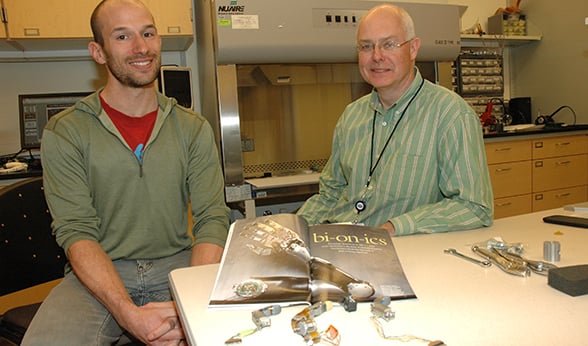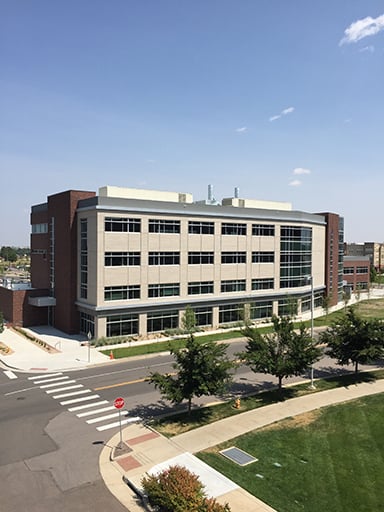The University of Colorado Anschutz Medical Campus brims with the best health care, technologies and research. Now the campus has taken a bold step forward to accelerate the transfer of world-class research and ideas to the marketplace.
CU Anschutz recently launched its own technology transfer office and rebranded the group to become CU Anschutz Innovations to align and leverage campus-specific expertise with key industry partnerships. Similarly, CU Boulder launched its own technology transfer office that’s focused on exploring innovation through its exceptional physics, biosciences, aerospace and engineering programs.
Previously, the CU Technology Transfer Office operated at the CU system level and quickly became an integral part of Colorado’s innovation ecosystem. But even more streamlined support and expertise is available now that the campuses, as of July 1, operate their own tech transfer offices. CU Anschutz Innovations will serve the transfer needs for CU Denver, while CU Boulder will handle requests for the University of Colorado Colorado Springs.
 Doctoral student Jabob Segil and Richard Weir, PhD, associate research professor in the Department of Engineering work on a robotic hand in a lab on the CU Anschutz Medical Campus. Their research is illustrative of the kinds of patient-centered innovations that take place regularly on the campus.
Doctoral student Jabob Segil and Richard Weir, PhD, associate research professor in the Department of Engineering work on a robotic hand in a lab on the CU Anschutz Medical Campus. Their research is illustrative of the kinds of patient-centered innovations that take place regularly on the campus.
Steve VanNurden, executive director of biotechnology relationships at CU Anschutz and CEO of the Fitzsimons Redevelopment Authority, said the change will result in more streamlined services to meet the needs of inventors that will hopefully lead to bringing more technologies to market for the betterment of patients worldwide. “What’s exciting about being at an academic medical center is you can play a role in these technologies getting to patients,” he said. “I’ve seen it in my career: certain technologies that I worked on ended up benefiting a family member or friends.”
Another key leader in CU Anschutz’s growing research and tech transfer capacity is CU Anschutz Innovations Director Kimberly Muller. Muller came to the campus in June 2015 from Yale University, where she served as deputy director of the Yale Entrepreneurial Institute and associate director of New Ventures.
Already, she has launched the Center for Innovation at Children’s Hospital Colorado, which is providing an opportunity for innovators to develop groundbreaking ideas that will enrich and save lives through better technology and health care.
“We really needed a different type of person to run CU Anschutz Innovations, not just someone from a licensing background,” VanNurden said of Muller. “Kim is also a patent attorney and has run startup companies, so she’s quite skilled in developing new approaches.”
In every approach, the CU Anschutz Innovations office will provide the vital conduit between the inventors and innovators on campus and the decision-makers in private enterprise.
“How do you best deliver technologies to patients? You match the business side to the science side,” VanNurden said. VanNurden came to CU Anschutz in 2012 from the Mayo Clinic, where he oversaw a patient-focused technology licensing and commercialization enterprise.
For instance, he said, physicians and other health care providers regularly come up with ideas that will advance care or fill an unmet need. “The goal is to make it easy for them to bring in an idea and then have a team evaluate it and get an early read from industry or key external groups,” VanNurden said. “As an academic medical center, there’s a lot of great science, research and health care that happens here. If we match that up with great business, then you really have something.”
 The 112,000-square-foot Bioscience 2 Building opened in 2015. A groundbreaking on Bioscience 3 is planned for next year.
The 112,000-square-foot Bioscience 2 Building opened in 2015. A groundbreaking on Bioscience 3 is planned for next year.
The CU Anschutz Medical Campus has emerged in the past decade a major economic engine in Colorado, providing more than $5.6 billion total economic impact. Since 2002, over 1,900 patent applications and more than 50 startup companies have been formed based on intellectual property developed on the campus.
VanNurden said 65 companies already operate out of the two Bioscience buildings at the Fitzsimons Redevelopment, with a groundbreaking for Bioscience 3 planned for next year.
The CU Anschutz Medical Campus is renowned for its direct links between academia and industry. For example, bioengineering students can connect their classroom work to the real world by taking advantage of the existing companies on campus or maybe they even start their own company.
“Those are the kinds of things we can do on this campus when we start to connecting different groups together,” VanNurden said. “It’s pretty unique, because there’s nothing that’s related to life science and medicine that we can’t do on the CU Anschutz Medical Campus. To accomplish much of it, you don’t even have to move your car.”
Because CU Anschutz Innovations is focused on life sciences and medicine, it will refer any non-medical ideas from CU Denver researchers to the CU Boulder tech transfer office.
The opportunities for technology transfer are seemingly boundless, and VanNurden and Muller are excited to create collaborative, yet streamlined, pathways between the research bench and a patient’s bedside.
“In the future we want to look at new models and different ways of doing things,” VanNurden said. “So how can a tech transfer office add value to a campus? Let’s reimagine that.”
To reach the Technology Transfer Offices, email ttocontact@cu.edu.
Story was written by University Communications and the Office of University Relations.




